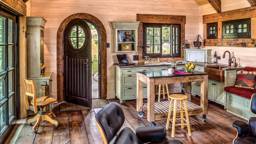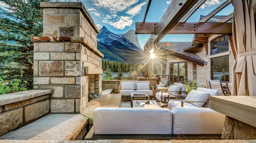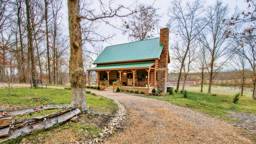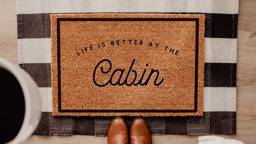Work time. Play-time. Be-on-time time.
For most of our lives the clock plays a significant role in managing our schedules. One of the most important benefits of cabin life is the ability to take back con-trol and live without the stresses of alarms, deadlines and the frantic rush to stay on schedule.
So take off your watch and relax.
At getaway homes, an easy way to track the passing of time is watching the sky. When the sun comes up, it’s time to get up. When the sun is straight up, it’s time for lunch. After watching another “best ever” sunset, it’s time for a good night’s sleep. Ahhh, that’s the way life is meant to be lived.
If you are interested in a little more accuracy, a well-crafted sundial might fill the bill – and dress up your yard or garden too.
Most sundials are mass-produced and purchased primarily for decoration in gardens, lawns or landscaping. Although they may add some visual appeal to the environment, these sundial replicas do not track time with great accuracy. Dave Kreiner, President of Accurate Sundials in Cedarburg, Wis., gets many calls from people saying they bought a sundial and are having problems setting it up to track time. “Since their sundial isn’t made for their location, it will never be right,” says Kreiner.
For most of our lives the clock plays a significant role in managing our schedules. One of the most important benefits of cabin life is the ability to take back con-trol and live without the stresses of alarms, deadlines and the frantic rush to stay on schedule.
So take off your watch and relax.
At getaway homes, an easy way to track the passing of time is watching the sky. When the sun comes up, it’s time to get up. When the sun is straight up, it’s time for lunch. After watching another “best ever” sunset, it’s time for a good night’s sleep. Ahhh, that’s the way life is meant to be lived.
If you are interested in a little more accuracy, a well-crafted sundial might fill the bill – and dress up your yard or garden too.
Most sundials are mass-produced and purchased primarily for decoration in gardens, lawns or landscaping. Although they may add some visual appeal to the environment, these sundial replicas do not track time with great accuracy. Dave Kreiner, President of Accurate Sundials in Cedarburg, Wis., gets many calls from people saying they bought a sundial and are having problems setting it up to track time. “Since their sundial isn’t made for their location, it will never be right,” says Kreiner.
Setting it up
A properly designed and installed sundial can accurately keep track of time; but it’s solar time, which can be up to 16 minutes different from clock time. Hopefully, that kind of time differential is not important at the cabin.
Sundials work by tracking the sun’s shadow across a base. The pin or plate used to cast the shadow is called a gnomon (pronounced NO-men). Bases usually feature a series of fine lines etched in the surface that resemble a clock face.
Telling time with a sundial requires establishing three important geographic criteria. As they say in real estate, success is based on location, location, and location. The criteria are:
1. The angle of the gnomon must match your latitude so you don’t have to manually adjust the device to compensate for the sun’s changing position in the sky from season to season.
2. The hour lines on the base must be laid out based on your latitude. Depending on where you live, the hour lines may not be the same distance apart throughout the day.
3. Your longitude must be considered in the way the hour lines are calculated and laid out.
Once you have your sundial at home, you’ll need to orient it to true north when placing it in your yard or garden.
A properly designed and installed sundial can accurately keep track of time; but it’s solar time, which can be up to 16 minutes different from clock time. Hopefully, that kind of time differential is not important at the cabin.
Sundials work by tracking the sun’s shadow across a base. The pin or plate used to cast the shadow is called a gnomon (pronounced NO-men). Bases usually feature a series of fine lines etched in the surface that resemble a clock face.
Telling time with a sundial requires establishing three important geographic criteria. As they say in real estate, success is based on location, location, and location. The criteria are:
1. The angle of the gnomon must match your latitude so you don’t have to manually adjust the device to compensate for the sun’s changing position in the sky from season to season.
2. The hour lines on the base must be laid out based on your latitude. Depending on where you live, the hour lines may not be the same distance apart throughout the day.
3. Your longitude must be considered in the way the hour lines are calculated and laid out.
Once you have your sundial at home, you’ll need to orient it to true north when placing it in your yard or garden.
Sundial time
While all this can get a bit complicated and confusing, the North American Sundial Society and companies like Accurate Sundials who specialize in sundial timepieces, can take care of most of these issues for you and advise you on the rest.
With 26 years of experience, Accurate Sundials’ Kreiner works with 273 different mathematical calculations based on the angle of the sun to design sundials specifically charted for each customer’s geographic location.
Makers of modern sundial timepieces even attempt to deal with the meridian, that moment every day when the sun reaches its highest point of the day. Based on early Roman timekeeping the meridian marks the line between a.m (ante meridiem) and p.m. (post meridiem). It can vary across states and even communities.
But striving for pinpoint accuracy is not really the point, is it?
Let’s just say that keeping cabin time is a lot more fun and interesting with a sundial. And for those who care, it’s pretty darn close to clock time.
So next time you arrive at the cabin, stick your watch in the kitchen drawer next to your car keys and wallet. And keep your eye on the sundial if you really feel you need to keep track of the hours and minutes.
Lou Dzierzak – editor of Cross Country Skier magazine and frequent contributor to Cabin Life – keeps his watch near his computer so he can make his deadlines.
Resources
• The North American Sundial Society, www.sundials.org
• Accurate Sundials, www.accuratesundials.com
• Precision Sundials, www.precisionsundials.com
While all this can get a bit complicated and confusing, the North American Sundial Society and companies like Accurate Sundials who specialize in sundial timepieces, can take care of most of these issues for you and advise you on the rest.
With 26 years of experience, Accurate Sundials’ Kreiner works with 273 different mathematical calculations based on the angle of the sun to design sundials specifically charted for each customer’s geographic location.
Makers of modern sundial timepieces even attempt to deal with the meridian, that moment every day when the sun reaches its highest point of the day. Based on early Roman timekeeping the meridian marks the line between a.m (ante meridiem) and p.m. (post meridiem). It can vary across states and even communities.
But striving for pinpoint accuracy is not really the point, is it?
Let’s just say that keeping cabin time is a lot more fun and interesting with a sundial. And for those who care, it’s pretty darn close to clock time.
So next time you arrive at the cabin, stick your watch in the kitchen drawer next to your car keys and wallet. And keep your eye on the sundial if you really feel you need to keep track of the hours and minutes.
Lou Dzierzak – editor of Cross Country Skier magazine and frequent contributor to Cabin Life – keeps his watch near his computer so he can make his deadlines.
Resources
• The North American Sundial Society, www.sundials.org
• Accurate Sundials, www.accuratesundials.com
• Precision Sundials, www.precisionsundials.com
The Useful Sundial
Sundials, such as this equatorial sundial, make beautiful lawn ornaments. And a properly designed and installed sundial can track time too. If your sundial is to function as a timepiece, three things are required:?
1. The angle of the gnomon (pin or plate that casts a shadow) must match your latitude.
2. The hour lines on the base must be laid out according to your latitude.
3. The hour lines must also be oriented based on your longitude.
Of course, like a compass, your sundial also must be oriented to true north when you place it in your yard.
Sundials, such as this equatorial sundial, make beautiful lawn ornaments. And a properly designed and installed sundial can track time too. If your sundial is to function as a timepiece, three things are required:?
1. The angle of the gnomon (pin or plate that casts a shadow) must match your latitude.
2. The hour lines on the base must be laid out according to your latitude.
3. The hour lines must also be oriented based on your longitude.
Of course, like a compass, your sundial also must be oriented to true north when you place it in your yard.
 Cabin Life, Cabin Living
Cabin Life, Cabin Living 











